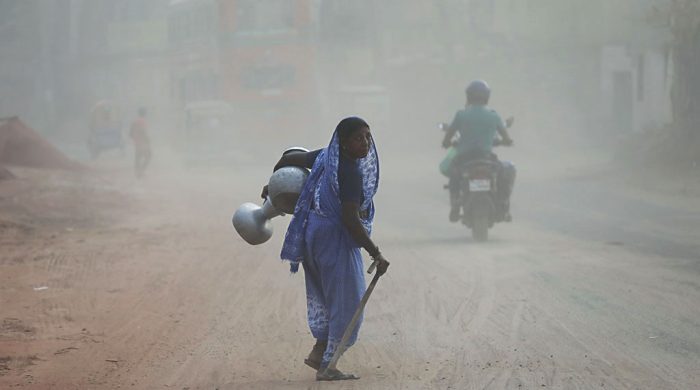Spread of Coronavirus: Are We Prepared?

- Update Time : Sunday, February 23, 2020
- 223 Time View

Coronavirus disease 2019 (COVID-19) is a respiratory illness that can spread from person-to-person. The virus that causes COVID-19 is a novel coronavirus that was first identified during an investigation into an outbreak in Wuhan, China. Coronaviruses are a large family of viruses that cause illness ranging from the common cold to more severe diseases such as Middle East Respiratory Syndrome (MERS-CoV) and Severe Acute Respiratory Syndrome (SARS-CoV). A novel Coronavirus (nCoV) is a new strain that has not been previously identified in humans.
Coronaviruses are zoonotic, which means they are transmitted between animals and people. SARS-CoV and MERS-CoV were transmitted from civet cats to humans and dromedary camels to humans, respectively. Several known Coronaviruses are circulating in animals that have not yet infected humans, according to reports of World Health Organisation (WHO).
COVID-19 is spreading from person-to-person in China, and limited spread among close contacts has been detected in some countries outside China, including Singapore and the Philippines. It is important to note that person-to-person spread can happen on a continuum. Some diseases are highly contagious (like measles), while other diseases are less so. At this time, it is unclear how easily or sustainably the virus that causes COVID-19 is spreading between people.
The Centre for Disease Control and Prevention (CDC), USA, shows COVID-19 mainly spreads in two ways. First, person-to-person spread that occurs by three ways (a) between people who are in close contact with one another (within about 6 feet), (b) via respiratory droplets produced when an infected person coughs or sneezes, and (c) these droplets can land in the mouths or noses of people who are nearby or possibly be inhaled into the lungs. Second, spread from contact with infected surfaces or objects. It may be possible that a person can get COVID-19 by touching a surface or object that has the virus on it and then touching their mouth, nose, or possibly their eyes, but this is not thought to be the primary way the virus spreads.
Common signs of infection include respiratory symptoms, fever, cough, shortness of breath, and breathing difficulties. In more severe cases, the disease can cause pneumonia, severe acute respiratory syndrome, kidney failure, and even death.
Of late, Harvard Professor (Epidemiologist) Marc Lipsitch says global coronavirus pandemic ‘likely,’ infecting 40-70% of the world this year. Other experts have recently given similar estimates. An adviser of the WHO has predicted that two-thirds of the global population may eventually contract COVID-19. Professor Gabriel Leung, the chair of public health medicine at Hong Kong University, says if the transmission estimate of 2.5 additional people for each infected rate is accurate, that will result in an “attack rate” that would affect 60 to 80 percent of the world’s population.
In these contexts, it is crucial to prepare for coronavirus “to take a foothold” that illustrates whether we have the national ability (e.g., creating awareness, generating country-specific knowledge, and skills) and capacity (e.g., access to modern technologies for surveillance and investigations) of preventing, care and treatment or whether we have been investing for these preparations? For improving ability, immediate initiatives are crucial at the national, regional, district and upazila levels. It can happen through informing, instructing, inspiring, insisting, and involving (5Is) people in different fields of mitigating COVID-19.
Understanding the basic protective measures against the new coronavirus such as (a) wash your hands frequently: washing your hands with soap and water or using alcohol-based hand rub eliminates the virus if it is on your hands, and (b) practice respiratory hygiene: covering your mouth and nose when coughing and sneezing prevent the spread of germs and viruses. If you sneeze or cough into your hands, you may contaminate objects or people that you touch. Maintain social distancing and avoid touching eyes, nose and mouth are very important for care. Moreover, if you have a fever, cough, and difficulty breathing, seek medical care early.
People’s awareness is needed about how to avoid consumption of raw or undercooked animal products; how to protect yourself and others from getting sick; when to use a mask; how to put on, use, take off and dispose of a mask; and is hand dryers effective in killing the new coronavirus? People clarifications are required questions around: does the new coronavirus affect older people, or are younger people also susceptible; can pets at home spread the new coronavirus; is it safe to receive a letter or a package from China; are antibiotics effective in preventing and treating the new coronavirus; and are there any specific medicines to prevent or treat the new coronavirus?
At the country’s level, we need substantial investment in improving technical capacities. First, enhancing country’s readiness, which is better to understand existing capacities in the area of detection and response to a novel coronavirus. Notably, the role of the national laboratory system (e.g., list the laboratory testing for COVID-19 from human and animal health sectors along with the tests performed (PCR- COVID-19 specific or pan COVID-19-, sequencing, culture, serology, and others) and surveillance and risk assessment. The latter is crucial for answering a plethora of questions: is there an event-based surveillance system in place, does the country have the ability to enhance current surveillance quickly, and is there a functioning respiratory disease surveillance system in place? Country readiness is also contingent on the rapid response team; command and coordination; risk communication; case management; infection prevention and control; and logistics, procurement, and supply management.
Second, patient management can be addressed by two points (a) clinical management of severe acute respiratory infection when novel coronavirus infection is suspected and (b) home care for patients with suspected novel coronavirus infection presenting with mild symptoms and management of contacts. The former point is all about recognition and sorting patients with severe acute respiratory infection (SARI), immediate implementation of appropriate infection prevention and control (IPC) measures, early supportive therapy and monitoring, collection of specimens for laboratory diagnosis, specific anti- COVID-19 treatments and others.
Third, risk communication and community engagement is an integral part of a national public health emergency response. The reasons include (a) one of the most important and effective interventions in public health response to any event is to communicate proactively; (b) regular and proactive communication and engagement with public and at-risk populations can help alleviate confusion and avoid misunderstandings; and (c) people have the right to be informed about and understand the health risks that they and their loved ones face. Key action steps of risk communication and community engagement are risk communication systems, internal and partner coordination, public communication, community engagement, addressing uncertainty and perceptions and managing misinformation, and capacity building.
Fourth, reducing risks of transmission of emerging pathogens from animals to humans in live animal markets are significant for further spreading of diseases. In light of available evidence and experience, WHO makes some recommendations such as anyone visiting live animal markets, wet markets, or animal product markets, should practice general hygiene measures, including regular hand washing with soap and potable water after touching animals and animal products. Moreover, the consumption of raw or undercooked animal products should be avoided. Fresh meat, milk, or animal organs should be handled with care to avoid cross-contamination with uncooked foods, as per good food safety practices.
And, fifth, management of ill travellers at points of entry – international airports, seaports and ground crossings – in the context of COVID-19 outbreak is vital. Actions are badly needed on public health preparedness and response for aviation sector and public health preparedness and response for maritime industry. Flagship publications of WHO’s “Handbook for the management of public health events onboard ships” and “Handbook for the inspection of ships and issuance of ship sanitation certificates” can provide critical information in these regards.
Coronavirus is the “worst enemy” you can ever imagine and poses a more significant global threat than terrorism, warned WHO. Research and innovation in mobilising the country’s action in response to novel coronavirus are urgent. Broadly, enhancing national ability and capacity to prevent coronavirus disease requires defining knowledge gaps, research priorities, and a governance framework. The country also needs setting key priorities and overall objectives of national research plan, and what governance model could contribute to successful funding and implementation of the research agenda during this outbreak?
The writer is an Associate Professor, Department of Agricultural Extension and Information System,
Sher-e-Bangla Agricultural University, Dhaka.



















